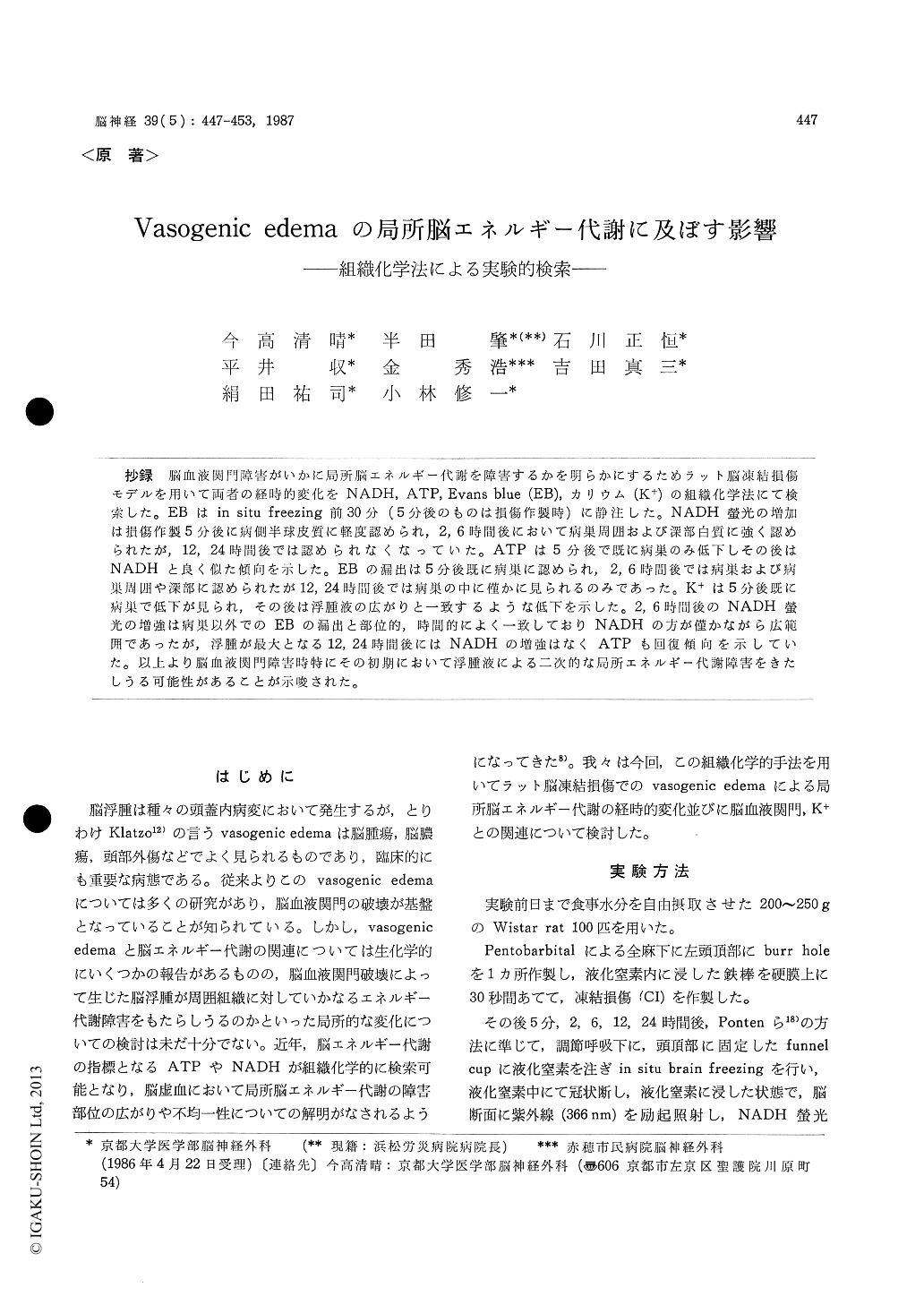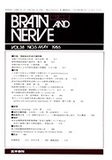Japanese
English
- 有料閲覧
- Abstract 文献概要
- 1ページ目 Look Inside
抄録 脳血液関門障害がいかに局所脳エネルギー代謝を障害するかを明らかにするためラット脳凍結損傷モデルを用いて両者の経時的変化をNADH, ATP, Evans blue (EB),カリウム(K+ )の組織化学法にて検索した。EBはin situ freezing前30分(5分後のものは損傷作製時)に静注した。NADH螢光の増加は損傷作製5分後に病側半球皮質に軽度認められ,2,6時間後において病巣周囲および深部白質に強く認められたが,12,24時間後では認められなくなっていた。ATPは5分後で既に病巣のみ低下しその後はNADHと良く似た傾向を示した。EBの漏出は5分後既に病巣に認められ,2,6時間後では病巣および病巣周囲や深部に認められたが12,24時間後では病巣の中に僅かに見られるのみであった。K+ は5分後既に病巣で低下が見られ,その後は浮腫液の広がりと一致するような低下を示した。2,6時間後のNADH螢光の増強は病巣以外でのEBの漏出と部位的,時間的によく一致しておりNADHの方が僅かながら広範囲であったが,浮腫が最大となる12,24時間後にはNADHの増強はなくATPも回復傾向を示していた。以上より脳血液関門障害時特にその初期において浮腫液による二次的な局所エネルギー代謝障害をきたしうる可能性があることが示唆された。
The changes of energy metabolism on vasogenic edema have been largely examined using bioche-mical quantitative assay. However, the relationship between the sequential changes and blood-brain barrier (BBB) breakdown is not well understood. In the present study, the sequential changes of energy metabolism and potassium in relation to BBB breakdown following the cold-induced brain edema were investigated histochemically.
Adult male Wistar rats, weighing 200-250g, were anesthesized with pentobarbital and a burr hole was made in the left parietal region. For evaluating the breakdown of BBB, 2.5% Evans blue (EB) was injected 30 min. before injury, except in the 5 min. model in which it was injected at the time of cold injury. An iron-bar precooled in liquid N2 was placed over the surface for 30seconds and they were frozen in situ in liquid N2 at 5min., 2hrs., 6hrs., 12hrs., and 24hrs., after producing the lesion. The frozen brain was sectioned using a precooled saw in the coronal plane. The brain section was placed in liquid N2bath and illuminated with 366nm light (UV) from a 200 watt mercury lamp and Corning filter 5840. NADH fluorescence was recorded photographically through Corning filter 3387 and 5562. Regional ATP and potassium content were investigated histochemically in thin sections with luciferine-luciferase method and Macallum's technique, re-spectively.
At 5min. after cold injury, leakage of EB was limited within the lesion. Potassium and ATP were decreased in the lesion. NADH fluorescence was increased slightly in the cortex around the lesion.
At 2 and 6 hrs. after cold injury, increased NADH fluorescence and decrease of ATP and potassium were noted around and just below the lesion, and the extent of EB leakage well corre-sponded to the area of increased NADH fluores-cence and decrease of ATP. The area of decreased potassium was wider than that of ATP.
At 12 and 24 hrs. after cold injury, no increased NADH fluorescence was noted. However a de-creased amount of EB was found within the lesion with little or no leakage around the lesion. The area with decreased potassium became wider, and extended to the contralateral white matter.
Thus, time course and extension of EB leakage well corresponded to the changes of increased NADH fluorescence and decrease of ATP, but not to the decreased area of potassium, which corre-sponded to the spread of brain edema. Thus, fai-lure of energy metabolism was noted in brain edema produced by cold injury. However, the intensity of NADH fluorescence was not increased at the time of maximal size in brain edema. This indi-cated that the failure of energy metabolism caused by vasogenic brain edema developed in the early stage of cold injury but it was fairly mild compared with cerebral ischemia
.

Copyright © 1987, Igaku-Shoin Ltd. All rights reserved.


